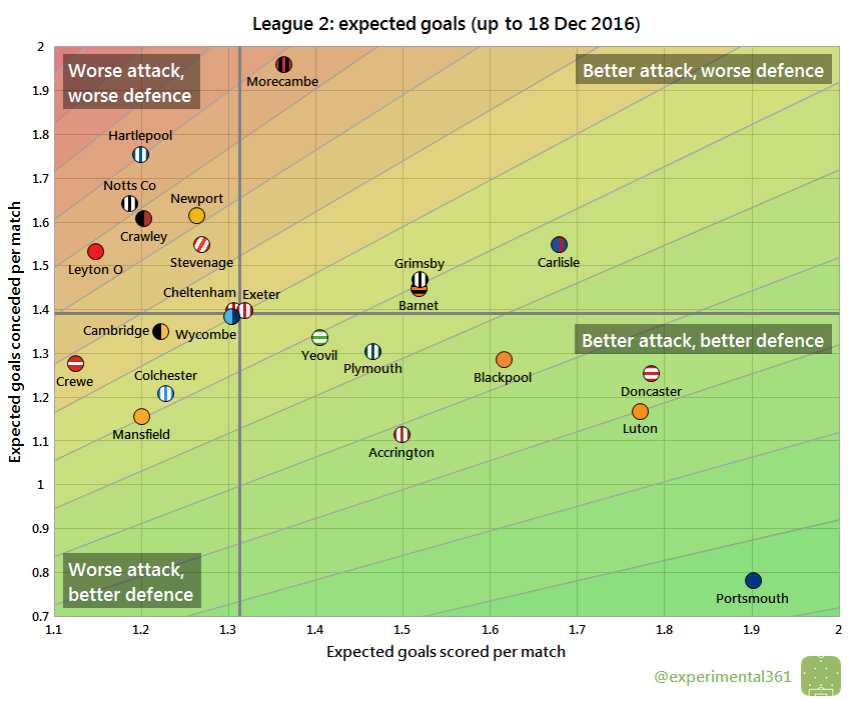Scatter graphics: League 2, 18 Dec 2016
It’s been roughly a month since the last set was produced, so I’ve updated the scatter graphics, each of which is explained briefly below and at length here.
Shot dominance
First of all, here is how the number of shots taken by each club compares with those they face in return. The average number of shots taken per match is on the horizontal and the average number faced is on the vertical, so bottom right (take plenty, allow few in return) is good while top left (take few, allow plenty) is bad. The stripes are like contours: the greener the stripe, the better the performance (and vice versa for red).
Portsmouth continue to look like the division’s most dominant team, although Blackpool have taken almost as many shots while Doncaster and Mansfield have allowed almost as few.
Despite lingering near the relegation zone, Accrington have consistently out-shot their opponents this season – I’ve really no idea what’s going wrong for them, although the next chart is pretty damning.
At the top of the graphic we can see that while Morecambe’s attack is pretty average, their defence remains ridiculously open. With over 16 shots allowed per match in a division where between 11 and 12 is more usual, they’re playing a dangerous game.
Attacking effectiveness
Now let’s look at attacking alone. The horizontal axis stays the same as in the graphic above, but now the vertical shows the average number of shots needed to score each league goal. Therefore bottom right is good (taking lots of shots and needing fewer efforts to convert) and top left is bad:
Here’s the problem for Accrington – or at least the chief symptom. With almost 14 shots needed to score each goal so far, they’re struggling to make their dominance count.
Doncaster and Carlisle meanwhile have sustained a promotion challenge by being exceptionally clinical in front of goal despite taking a relatively modest number of shots.
Hartlepool have benefited from some sharp finishing too: they’ve scored a slightly above-average amount of goals despite only Crewe creating fewer chances.
Defensive effectiveness
Next let’s look at the defensive situation – basically take the above chart and replace the word “taken” for “faced” on both axes. Now top left is good – facing fewer shots and able to soak up more per goal conceded – and bottom right is bad:
At the top of the graphic, Luton have soaked up an impressive number of chances for each goal conceded. Fellow high-fliers Plymouth and Carlisle have also absorbed plenty of punishment, with the Cumbrians allowing their opponents a surprisingly high volume of attempts – this could well trip them up if they’re not careful.
One of their promotion rivals is at the opposite end of the spectrum: Doncaster have allowed impressively few shots but have struggled to keep the few that do slip through out of their net. In fact all five of the clubs with the fewest chances allowed are below average at repelling them.
Expected goals
Finally here’s an attempt at correcting the first graphic for the quality of chances created and allowed, using the same “expected goals” values that power my shot timelines (explained here). The reason for doing this is that the results tend to correlate more strongly with performance than when we treat all shots equally:
When we correct for shot quality Portsmouth are still way out in front, having created chances of over twice the quality that they allow. Nobody’s close to them on either axis, although Doncaster and Luton are nearer on the attacking front than anyone can manage defensively.
We can see Carlisle’s dilemma clearly here: only three clubs are creating better chances but they’re also worryingly open defensively. Mansfield are the opposite, having one of the sturdiest defences while being below-average up front.
While not technically in the scary top left quadrant, Morecambe should remain worried due to the quality of chances that their defence is allowing: a slightly above-average attack may not be enough to save them if they can’t tighten things up at the back.





You must be logged in to post a comment.